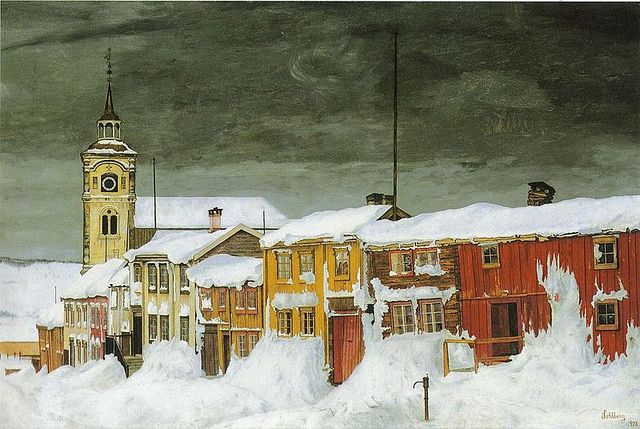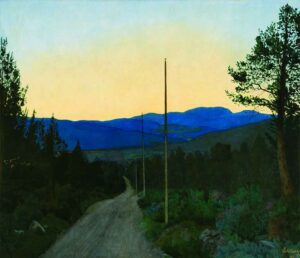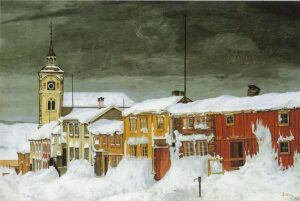

In most of Harald Sohlberg’s paintings there are no people. It took me a while to realise this, because signs of recent human domestic activity are everywhere – modest white houses glimpsed through encroaching forest, telegraph poles on empty roads, tables set for summer drinks on lakeside balconies, wintry streets of rough wooden buildings, defiant churches foregrounded by graves or mocked by pulsing stormclouds above the spires. The effect is of intense and mysterious natural beauty undercut by a disquiet that you can’t quite identify, at least not at first.
This haunted absence is particularly apparent in the summer paintings. In all of these, Sohlberg captures discrete moments in the slow dusk familiar to those who live in the north, the half light that lingers long after people have finally gone to bed. Here, the landscape stays awake, slowly changing colour as the light drains, by imperceptible increments, from sky, lake and forest.
The Country Road (1905) is an intimate portrait of northern summer twilight. An empty lane winds toward a distant line of hills, violet against a luminous yellow-greenish sky. The surrounding woods have begun to lose definition; telegraph poles, which don’t appear to have wires, only emphasise the sense of timeless isolation. The light in Fisherman’s Cottage, painted a year later, has retreated further – this is a nocturne in shades of midnight blue. The lonely white cottage is chastened by the vast watery expanses beyond it, and almost hidden by a screen of towering black trees. The painstaking brushwork in these pines, almost Japanese in style, gives the image a dreamlike clarity. A window in the house is lit, or is it just a reflection? The same house – or one very like it – appears in Sun Gleam (1894), this time in broad daylight. What is interesting here is the realisation that the house, despite the benign sunshine, is not the focus of the picture. An earthy path tries to lead the eye toward it, but it is the trees’ shadows that dance on the ground, and the trees themselves whose restless shapes claim your attention.
Sohlberg himself admitted to being inspired, romantically, by the awareness of his own insignificance in nature. During a visit to the Rondane mountains in 1899 he experienced an epiphany, “a rush of emotion greater than I had ever experienced before…The longer I stood gazing at the scene the more I seemed to feel what a solitary and pitiful atom I was in an endless universe.” He became obsessed by one of these mountains and painted several versions as he strove to show his own terror and delight in isolation through the shifting blues on snow. In these, as in The Country Road and Fisherman’s Cottage, light seems to glow through layers of paint from some unknown space below or behind it, resulting in colour which could be described as hypernatural.
His paintings of small copper-mining town of Roros, 400 km north of Oslo, while equally deserted, are markedly different in tone: the red wooden houses and rough empty streets, man made, have a scrappy, temporary look against wintry hills, and those hills, in turn, seem diminished, de-romanticised, marginalised, a human resource rather than an inspiration. And Night, Roros Church (1903), is truly unnerving: a pallid triangular troll-like building, hemmed in by a cramped graveyard, scattered with black crosses and disordered coffinlike gravestones. The houses of the living lie just beyond, but there are no mourners here. Similarly, Street in Roros, painted the previous year, shows wooden clapboard buildings with torn posters, while a dominating churchtower points to an ominous sky, heaving with with stormcloud and black birds.
Absence of people, freedom from people – for Sohlberg’s contemporaries these works would have suggested m+emories of summers past, childhood images almost forgotten, while others might have identified a tension between rural Norway and the encroachment of industrial development. But in 2019 the impression is different – it is hard to avoid the idea of recent abandonment, of something leaking away with the light, the suspicion that you are looking at a post-human landscape. And in this sense the paintings have a highly modern resonance at a time when humanity is confronted daily by a brutal awareness of what is being lost in nature, haunted by memories of what we once had.
Josephine Gardiner
Volume 34 no 1 September – October 2019 p 29
Harald Sohlberg (1869-1935). First exhibition outside Norway, Dulwich Picture Gallery London, February to June 2019.

